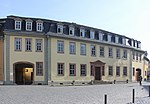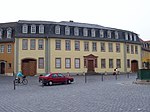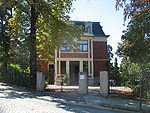Klassik Stiftung Weimar

The Klassik Stiftung Weimar (Classical Foundation Weimar) is one of the largest and most significant cultural institutions in Germany. It owns more than 20 museums, palaces, historic houses and parks, as well as literary and art collections, a number of which are World Heritage Sites.It focuses on the Weimar Classicism period, but also covers 19th and 20th century art and culture with properties associated with Franz Liszt, Friedrich Nietzsche, Henry van de Velde and the Bauhaus.Eleven of its properties are listed as part of the Classical Weimar World Heritage Site and the Haus am Horn is part of the Bauhaus and its Sites in Weimar, Dessau and Bernau World Heritage Site.The foundation was created on 1 January 2003 through the merger of the Stiftung Weimarer Klassik and the Kunstsammlungen zu Weimar. It was known from 2003 to 2006 as the Stiftung Weimarer Klassik und Kunstsammlungen. The Klassik Stiftung Weimar is a member of the Konferenz Nationaler Kultureinrichtungen, a union of more than twenty cultural institutions in the five new states of Germany which were formerly part of the German Democratic Republic.
Excerpt from the Wikipedia article Klassik Stiftung Weimar (License: CC BY-SA 3.0, Authors, Images).Klassik Stiftung Weimar
Windmühlenstraße,
Geographical coordinates (GPS) Address Nearby Places Show on map
Geographical coordinates (GPS)
| Latitude | Longitude |
|---|---|
| N 50.973 ° | E 11.326 ° |
Address
Hauptfriedhof
Windmühlenstraße
99425 , Westvorstadt
Thuringia, Germany
Open on Google Maps











